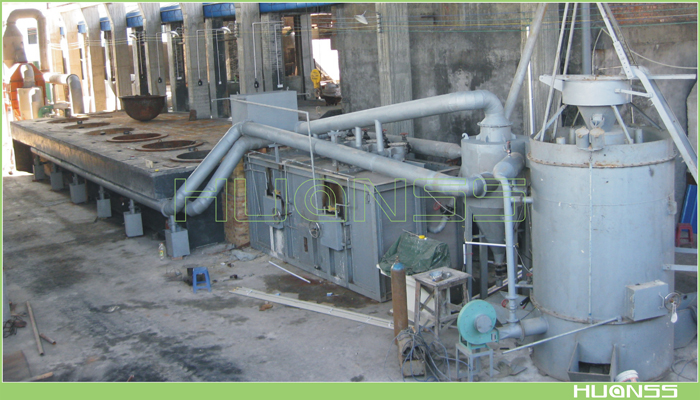Lead smelting reverberatory furnace

The conventional reverberatory furnace for non-ferrous metal smelting is a chamber-fired flame furnace. The heat transfer mode in the furnace depends on the reflection of the flame, and more importantly, on the radiation heat transfer of the furnace roof, furnace wall and incandescent gas. Reflector is widely used in non-ferrous metal smelting, such as drying, roasting, refining, melting and slag treatment. The reverberatory furnace has always been the main equipment for smelting non-ferrous metals. However, because the conventional reverberatory furnace must stop slag cleaning in every furnace, it can not work continuously, which greatly affects the production capacity. What is more serious is that, due to frequent start-up and shutdown, the alternation of heat and cold has great damage to refractories in the furnace, and the service life of the furnace is also greatly shortened.
Our self-developed high-efficiency energy-saving reverberatory furnace not only has the advantages of conventional reverberatory furnace, but also allows high-temperature flue gas to pass through the material layer, which is in close contact with the flame. It greatly improves the heat transfer efficiency, fully absorbs the heat in the furnace, and shortens the smelting time. Initially, the material layer thickness is 100-150 mm, evenly covered with the bed, and the door ignition slowly warms up. The furnace temperature can be continuously fed through two screw feeders when it rises to 800 (?) C to keep the balance between the feeding quantity and the melting quantity. Hot flue gas and molten metal enter the lower molten pool through fine holes uniformly distributed on the furnace bed. When the molten metal reaches a certain amount, the discharging valve of the molten pool is opened and the molten metal is discharged into the low-level melting pot. The hot flue gas in the furnace passes through the bottom of the low-level melting pot, which keeps the molten metal at a higher temperature and removes the scum from the surface of the melting pot. Generally, four melting pots can be set up in a smelting system to ensure continuous production and replacement. At the same time, when the flue gas passes through the space at the bottom of the melting pot, the dust in the flue gas deposits at the bottom of the pot, so the bottom of the pot is also the ash collecting room.
The hot flue gas discharged from the bottom of the melting pot still has high heat energy. In order to make full use of the waste heat of the flue gas, the whole melting system is equipped with waste heat boiler and air preheater. Waste heat boiler can effectively reduce smoke exhaust temperature and produce hot water or basketball steam, which can be used for staff canteen steam and staff bathing, heating, industrial steam, etc. Air preheater can further reduce smoke temperature and protect the environment. At the same time, the cold air is heated to 160 ~180 C. A bag filter is installed behind the air preheater, and the fly ash in the flue gas is fully captured and collected. The heated hot air can be used as heat oxygen supply for gas generator and reflex furnace to improve combustion efficiency. The device has the advantages of small size, long service life, energy saving, environmental protection, continuous production and other conventional reverberatory furnace incomparable advantages.
The reverberatory furnace adopts a cylindrical horizontal double-layer structure, the lining is made of high quality refractory materials, and the rotary arch lining is made of magnesia bricks or magnesia-alumina bricks. The bottom of the furnace is sintered with magnesia and iron oxide. Each reverberatory furnace is equipped with two screw feeders, blowers, induced draft fans, waste heat boilers, air preheaters, biochemical dust collectors, cyclone dust collectors, and a set of gas producers and swirl gas burners. According to the user's needs, we can provide bag filter system (bag filter, air compressor, ash conveying equipment, etc.).
It is economical, practical and easy to operate. Other uses: It has wide applicability in machinery, metallurgy, building materials, ceramics, chemical industry, etc.
Daily output of reverberatory furnace: 16-100T
Air volume of biochemical precipitator: 3500-11000m3/h














